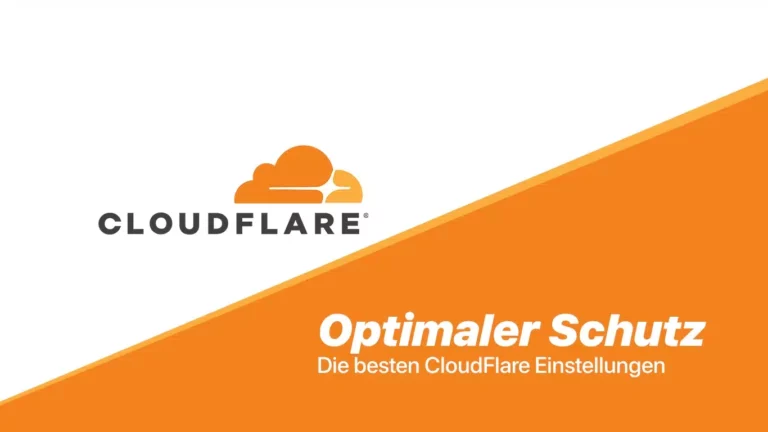Cloudflare offers a variety of settings that you can use to optimize the performance and security of your WordPress website.
In this guide, I'll show you the best Cloudflare settings for optimal performance—all with the free plan.
Skip to content | Cloudflare Settings
1. DNS
Enable proxy: Enable the proxy only for your main domain and the "www" entry. You can also enable the proxy for subdomains if they point to a website. Important: Disable the proxy for control panels or entries that point to external servers.

TTL (Time to Live): Set a higher TTL when the proxy is disabled so your DNS information stays in the cache longer. When migrating to a new server, lower the TTL so changes take effect faster.
2. SSL/TLS
- SSL: Select "Full." This allows you to use SSL without enforcing overly strict connections. "Full (strict)" can slow down SSL handshakes and thus affect loading times.
- Always Use HTTPS: This setting should be enabled to automatically redirect visitors to the HTTPS version.
- Automatic HTTPS Rewrites: Enable this option unless you have content that works exclusively over HTTP.
- Minimum TLS version: Set this setting to the lowest version for maximum browser compatibility. Only select a higher version for specific security requirements, such as in certain industries (healthcare, legal).
- TLS 1.3: Enable it for improved security and performance.
- Opportunistic Encryption: Enable to allow TLS for other protocols such as HTTP/2.
- Onion Routing: Enable to protect the privacy of Tor network users.
- Edge Certificates: The free shared certificates are sufficient in most cases.
3. Speed
Here I recommend applying all site recommendations:

- Auto Minify: Enable all three options (JavaScript, CSS, HTML). This compresses the code to reduce loading times.
- Breadli: Turn this setting on to benefit from modern compression technology.
- Rocket Loader: Leave this setting off as it often causes compatibility issues.
- Image resizing: A paid service that is not necessary if you already use image optimization plugins.
- Railgun: A paid service that can increase website speed. However, it can also affect display and functionality. Caution is advised here.
4. Caching

- Purge Cache: Use this feature if you have made changes to your website and want them to be visible immediately.
- Caching Level: “Standard” is the safest option because it can cache assets with or without query strings.
- Browser Cache Expiration: The default setting of 4 hours is sufficient. If your website content rarely changes, you can choose a longer period (e.g., 2-8 days).
- Always Online: Enable to ensure your website continues to display even if the server fails.
- Enable Query String Sort: A very useful feature for e-commerce websites, as it allows Cloudflare to treat different URLs with the same but differently ordered query strings as the same page. This significantly reduces the load on the origin server.
5. Security

- Managed Rules: Enable the Web Application Firewall (WAF) for additional protection.
- IP Access Rules: Here you can allow, block, or challenge specific IP addresses. This setting is useful if you are frequently blocked by your own website.
- Rate Limiting: This paid feature blocks IPs based on defined usage patterns to reduce malicious traffic.
- User Agent Blocking: Block specific browsers or applications to protect your website from unwanted traffic.
6. Network

- HTTP/2: Enable to benefit from faster loading.
- HTTP/3 with QUIC (BETA): Join the waitlist and activate it as soon as it's available. It offers additional speed benefits.
- IPv6 compatibility: Turn this setting on to support traffic from modern networks.
- WebSockets: Turn it on if your website needs it.
- IP geolocation: Enable to record the origin of visitors, which is useful for analytics purposes.
7. Scrape Shield

- Email Address Obfuscation: Activate to protect your email address from bots.
- Hotlink Protection: This setting is disabled by default. In most cases, it's okay if other websites link to your images, as they're provided by Cloudflare.
More tips
- Development mode: Enable this if you constantly make design or style changes to your website. This ensures you see the most recent version of your website, not the cached one.
- Page Rules: There are numerous guides on which rules you can set here. One simple option is to create a rule to disable caching for specific pages, such as the shopping cart or checkout in WooCommerce.
- Argo: A paid service for faster DNS times. It's more worthwhile for large websites with high traffic and dynamic content, such as WooCommerce stores.
Frequently asked questions
Final words
These specific settings will help you unlock the full potential of your free Cloudflare account. Proper configuration will significantly improve both the performance and security of your WordPress website.
Many of these settings are not only free, but also require a little time and effort to select and adjust the optimal options. By making these adjustments, you can ensure that your website not only loads faster but is also better protected against potential threats. And that's exactly what Cloudflare is all about.
If you have any questions or concerns, please post them in the comments section!



